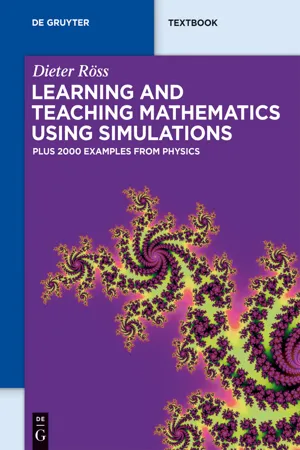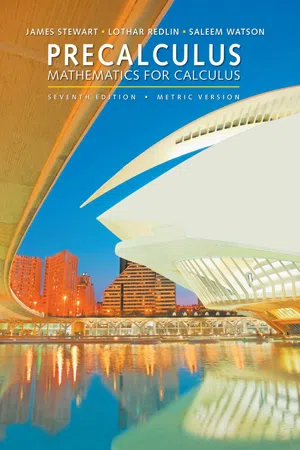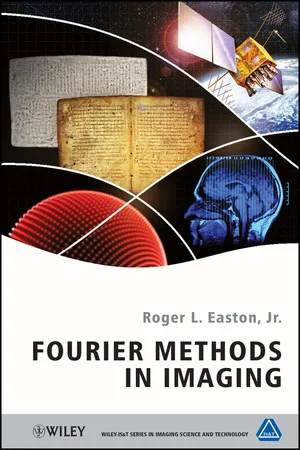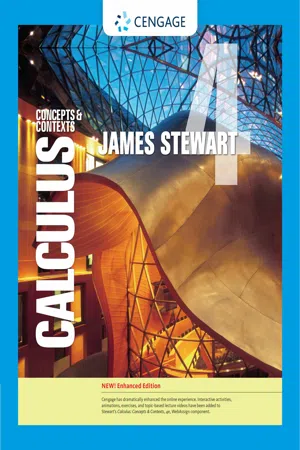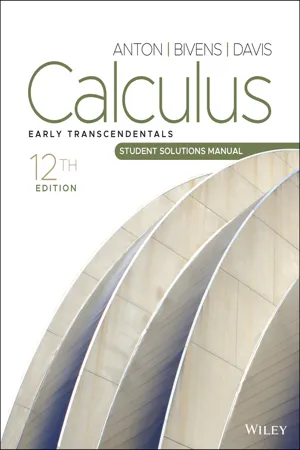Mathematics
3-Dimensional Vectors
3-dimensional vectors are mathematical objects that have both magnitude and direction in three-dimensional space. They are commonly represented as ordered triples of numbers and are used to describe physical quantities such as force, velocity, and displacement. In mathematics, 3-dimensional vectors are essential for understanding spatial relationships and solving problems in geometry, physics, and engineering.
Written by Perlego with AI-assistance
Related key terms
1 of 5
6 Key excerpts on "3-Dimensional Vectors"
- eBook - PDF
Learning and Teaching Mathematics using Simulations
Plus 2000 Examples from Physics
- Dieter Röss(Author)
- 2011(Publication Date)
- De Gruyter(Publisher)
In quantum mechanics one works with vectors in the infinitely dimensional Hilbert space. Plane problems can be described by two-dimensional vectors that can be considered to lie in the complex plane. Vector algebra and vector analysis, in which partial differentiations take place, are an especially important mathematical tool of theoretical physics and therefore are often treated in depth in many textbooks for first year students.Their objects and oper-ations are not easily accessible to the untrained imagination. Therefore, the following sections concentrate only on the interactive visualization of fundamental aspects. 8.2 3D-visualization of vectors The classical visual presentation of a vector is an arrow in space, whose length defines an absolute value and whose orientation defines a direction. The place at which the arrow is situated is arbitrary; one can, for example, let it start as a zero-point vector from the origin of a Cartesian system of coordinates. Thus its endpoint (the tip of the arrow) is described by the three space coordinates x; y; z in this system of coordinates. Its length a , also referred to as the absolute value of the vector, is obtained from the theorem of Pythagoras as a D p x 2 C y 2 C z 2 . It obviously does not matter how the system of coordinates, with respect to which the coordinates of the vector are defined, is orientated in space. Under a change of the coordinate system (translation or rotation), the individual coordinates also change, but the position and length of the vector are not affected by this. They are invariant under translation and rotation. This property provides the definition of a vector. Quantities that can be characterized by specifying a single number for every point in space are called scalar , in contract to vectors; an example would be a density-or temperature distribution. The three-dimensional zero-point vector represents the position coordinates of a point in space. - No longer available |Learn more
- James Stewart, Lothar Redlin, Saleem Watson(Authors)
- 2016(Publication Date)
- Cengage Learning EMEA(Publisher)
Due to electronic rights, some third party content may be suppressed from the eBook and/or eChapter(s). Editorial review has deemed that any suppressed content does not materially affect the overall learning experience. Cengage Learning reserves the right to remove additional content at any time if subsequent rights restrictions require it. 630 CHAPTER 9 ■ Vectors in Two and Three Dimensions 9.1 VECTORS IN TWO DIMENSIONS ■ Geometric Description of Vectors ■ Vectors in the Coordinate Plane ■ Using Vectors to Model Velocity and Force In applications of mathematics, certain quantities are determined completely by their magnitude—for example, length, mass, area, temperature, and energy. We speak of a length of 5 m or a mass of 3 kg; only one number is needed to describe each of these quantities. Such a quantity is called a scalar. On the other hand, to describe the displacement of an object, two numbers are re- quired: the magnitude and the direction of the displacement. To describe the velocity of a moving object, we must specify both the speed and the direction of travel. Quantities such as displacement, velocity, acceleration, and force that involve magnitude as well as direction are called directed quantities. One way to represent such quantities math- ematically is through the use of vectors. ■ Geometric Description of Vectors A vector in the plane is a line segment with an assigned direction. We sketch a vector as shown in Figure 1 with an arrow to specify the direction. We denote this vector by AB > . Point A is the initial point, and B is the terminal point of the vector AB > . The length of the line segment AB is called the magnitude or length of the vector and is denoted by 0 AB > 0 . We use boldface letters to denote vectors. Thus we write u AB > . Two vectors are considered equal if they have equal magnitude and the same direction. - eBook - PDF
- Roger L. Easton Jr.(Author)
- 2010(Publication Date)
- Wiley(Publisher)
3 Vectors with Real-Valued Components 3.1 Scalar Products At this point, the path of this discussion makes a significant change in direction to consider the concepts of vector analysis. This study is useful for two reasons. First, many of the mathematical concepts used to analyze imaging systems may be usefully expressed in terms of scalars, vectors, and matrices. Second, the mathematical tools of discrete vectors and matrices may be generalized to functions of continuous variables. For example, the concepts of the scalar product of two vectors and the projection of one vector onto another may be generalized easily and are essential in the analysis of imaging systems. The discussion of this chapter follows that of many texts in linear algebra, such as that of Strang (2005). Similar material is presented in Parker (1990). Any physical or mathematical quantity whose amplitude may be decomposed into “directional” components, i.e., components directed along different axes, is often represented conveniently as a vector. In this discussion, vectors are denoted by bold-faced underscored lower-case letters, e.g., x . For example, for a vector with two real-valued components the 3-D vector x is specified by a vertical column of the three ordered numerical components: x ≡ x 1 x 2 x 3 (3.1) The usual notation for a vector with N elements is a column of N individual numerical scalars, where the parameter N is the dimensionality of the vector. If N = 2 or N = 3, the vector is usually interpreted as specifying a location in the 2-D plane or 3-D volume. The interpretation is extended to use vectors with four or more components to specify Cartesian coordinates of a location in a nonphysical space. Though such a vector is more difficult to visualize in these terms, it is easy to visualize if we think of it as a 1-D array of values. - David Halliday, Jearl Walker, Patrick Keleher, Paul Lasky, John Long, Judith Dawes, Julius Orwa, Ajay Mahato, Peter Huf, Warren Stannard, Amanda Edgar, Liam Lyons, Dipesh Bhattarai(Authors)
- 2020(Publication Date)
- Wiley(Publisher)
Given a vector’s components, we can fnd the magnitude and orientation of the vector a with a = √ a 2 x + a 2 y and tan = a y a x . Why study physics? Physics deals with a great many quantities that have both size and direction, and it needs a special mathematical language — the language of vectors — to describe those quantities. This language is also used in engineering, the other sciences and even in common speech. If you have ever given directions such as ‘Go five blocks down this street and then hang a left,’ you have used the language of vectors. In fact, navigation of any sort is based on vectors, but physics and engineering also need vectors in special ways to explain phenomena involving rotation and magnetic forces, which we get to in later chapters. In this chapter, we focus on the basic language of vectors. Pdf_Folio:30 Vectors and scalars A particle moving along a straight line can move in only two directions. We can take its motion to be positive in one of these directions and negative in the other. However, for a particle moving in three dimensions, a plus sign or minus sign is no longer enough to indicate a direction. Instead, we must use a vector. 1. Vector. It has magnitude (size) and direction. 2. Vector quantity. Any quantity such as displacement that has magnitude and direction. 3. Scalar quantity. Any quantity such as temperature that has magnitude but no direction. A temperature might have a plus or minus sign but certainly does not point. You have a certain body temperature, but if that compelled you to point in a certain direction, your pointing would be comical. Displacement vector FIGURE 3.1 A particle undergoing displacement from A to B. A B When a particle changes its position by moving from A to B as in figure 3.1, we say that it undergoes a displacement from A to B, which we represent with an arrow pointing directly from A to B..- eBook - PDF
Calculus
Concepts and Contexts, Enhanced Edition
- James Stewart(Author)
- 2018(Publication Date)
- Cengage Learning EMEA(Publisher)
Due to electronic rights, some third party content may be suppressed from the eBook and/or eChapter(s). Editorial review has deemed that any suppressed content does not materially affect the overall learning experience. Cengage Learning reserves the right to remove additional content at any time if subsequent rights restrictions require it. 648 CHAPTER 9 VECTORS AND THE GEOMETRY OF SPACE 38. Suppose a vector makes angles , , and with the positive -, -, and -axes, respectively. Find the components of and show that (The numbers , , and are called the direction cosines of .) 39. If and , describe the set of all points such that . 40. If , , and , describe the set of all points such that , where . 41. Figure 16 gives a geometric demonstration of Property 2 of vectors. Use components to give an algebraic proof of this fact for the case . 42. Prove Property 5 of vectors algebraically for the case . Then use similar triangles to give a geometric proof. 43. Use vectors to prove that the line joining the midpoints of two sides of a triangle is parallel to the third side and half its length. n 3 n 2 k r 1 r 2 r r 1 r r 2 k x , y r 2 x 2 , y 2 r 1 x 1 , y 1 r x , y r r 0 1 x , y , z r 0 x 0 , y 0 , z 0 r x , y , z a cos cos cos cos 2 cos 2 cos 2 1 a z y x a 44. Suppose the three coordinate planes are all mirrored and a light ray given by the vector first strikes the -plane, as shown in the figure. Use the fact that the angle of incidence equals the angle of reflection to show that the direc-tion of the reflected ray is given by . Deduce that, after being reflected by all three mutually perpendicular mirrors, the resulting ray is parallel to the initial ray. (American space scientists used this principle, together with laser beams and an array of corner mirrors on the moon, to calculate very precisely the distance from the earth to the moon.) b a z x y b a 1 , a 2 , a 3 x z a a 1 , a 2 , a 3 So far we have added two vectors and multiplied a vector by a scalar. - Howard Anton, Irl C. Bivens, Stephen Davis(Authors)
- 2022(Publication Date)
- Wiley(Publisher)
Three-Dimensional Space; Vectors Exercise Set 11.1 1. (a) (0, 0, 0), (3, 0, 0), (3, 5, 0), (0, 5, 0), (0, 0, 4), (3, 0, 4), (3, 5, 4), (0, 5, 4). (b) (0, 1, 0), (4, 1, 0), (4, 6, 0), (0, 6, 0), (0, 1, −2), (4, 1, −2), (4, 6, −2), (0, 6, −2). 3. Corners: (−2, 4, −1), (−2, 0, −1), (3, 0, −1), (3, 4, 5), (−2, 4, 5), (3, 0, 5). (3,0,–1) (–2,0,–1) (3,4,–1) (–2,4,–1) (–2,4,5) (–2,0,5) (3,0,5) (3,4,5) y x z 5. (a) A single point on that line. (b) A line in that plane. (c) A plane in 3-space. 7. (a) Let the base of the box have sides a and b and diagonal d 1 . Then a 2 + b 2 = d 2 1 , and d 1 is the base of a rectangular of height c and diagonal d, with d 2 = d 2 1 + c 2 = a 2 + b 2 + c 2 . (b) Two unequal points (x 1 , y 1 , z 1 ) and (x 2 , y 2 , z 2 ) form diagonally opposite corners of a rectangular box with sides x 1 − x 2 , y 1 − y 2 , z 1 − z 2 , and by Part (a) the diagonal has length (x 1 − x 2 ) 2 + (y 1 − y 2 ) 2 + (z 1 − z 2 ) 2 . 9. The diameter is d = (1 − 3) 2 + (−2 − 4) 2 + (4 + 12) 2 = √ 296, so the radius is √ 296/2 = √ 74. The midpoint (2, 1, −4) of the endpoints of the diameter is the center of the sphere. 11. Label the given points A(5, 4, 2), B(7, 2, 3), and C (6, 7, 6). (a) |AB| = (7 − 5) 2 + (2 − 4) 2 + (3 − 2) 2 = √ 4 + 4 + 1 = 3; |AC | = (6 − 5) 2 + (7 − 4) 2 + (6 − 2) 2 = √ 1 + 9 + 16 = √ 26; |BC| = (6 − 7) 2 + (7 − 2) 2 + (6 − 3) 2 = √ 1 + 25 + 9 = √ 35. |AB| 2 + |AC | 2 = 9 + 26 = 35 = |BC | 2 , so the points A, B, C are vertices of a right triangle. (b) A = 90 ◦ ; the vertex A(5, 4, 2) is the 90 ◦ angle. (c) Perimeter ΔABC = |AB| + |AC | + |BC| = 3 + √ 26 + √ 35. (d) Area ΔABC = 1 2 · |AB| · |AC | = 1 2 · 3 · √ 26 = 3 √ 26 2 . 297 298 Chapter 11 13. (a) (x − 7) 2 + (y − 1) 2 + (z − 1) 2 = 16. (b) (x − 1) 2 + y 2 + (z + 1) 2 = 16. (c) r = (−1 − 0) 2 + (3 − 0) 2 + (2 − 0) 2 = √ 14, (x + 1) 2 + (y − 3) 2 + (z − 2) 2 = 14.
Index pages curate the most relevant extracts from our library of academic textbooks. They’ve been created using an in-house natural language model (NLM), each adding context and meaning to key research topics.
